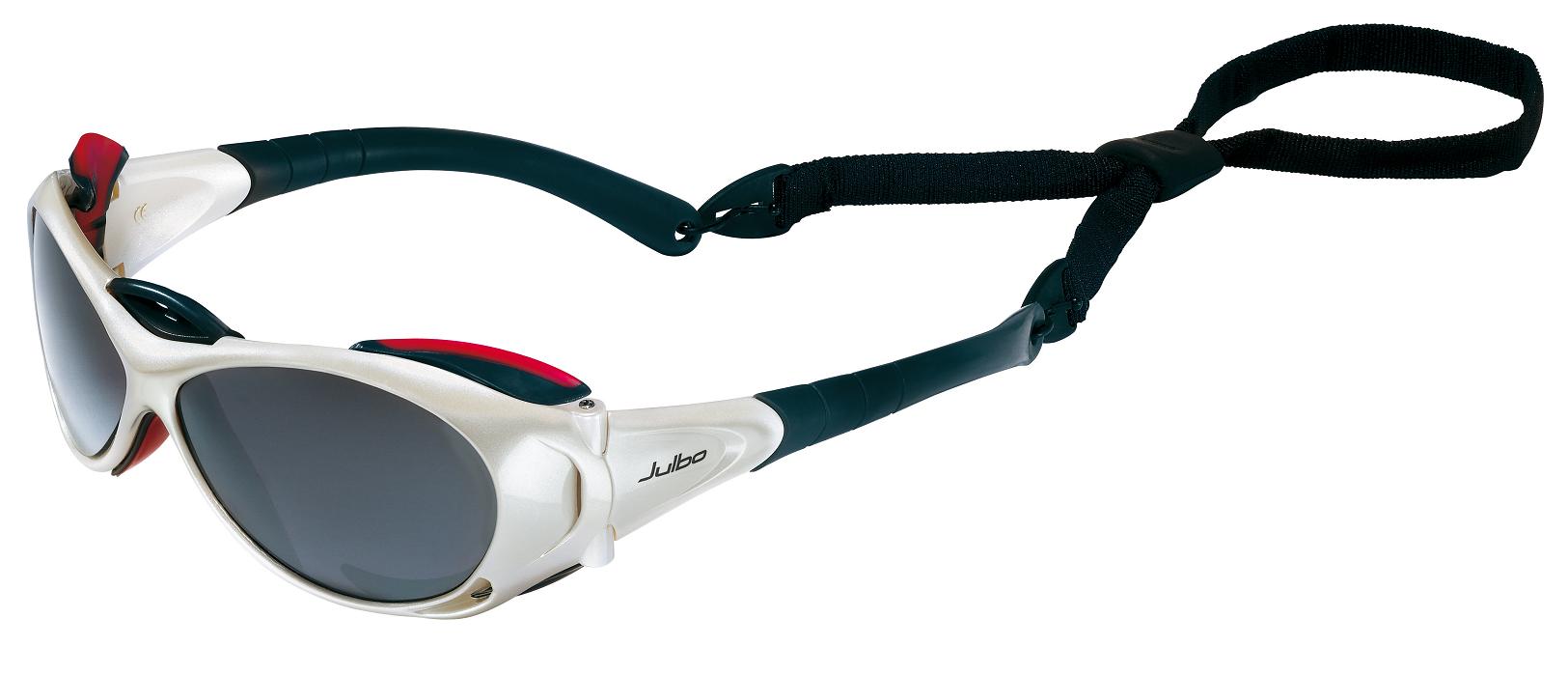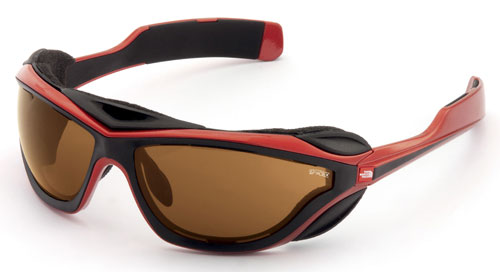|
Mountain Sunglasses
Sunglasses for climbing and skiing in the mountains have a lot of difficult and conflicting requirements placed upon
them.
They have to protect your eyes from the Sun and wind. They need to provide undistorted
vision, and also provide good peripheral vision both side to side and up and down. They need to be durable, light weight,
compact, comfortable to wear all day long, and they need to resist fogging.
They need to be dark enough to protect your eyes from bright snow and glaciers and high altitude
sun, but they also need to be light enough to allow for clear vision in overcast conditions. The latest crop of photochromatic
lenses that darken or lighten depending on available light help to solve this issue.
Unfortunately, all of these desirable
traits result in conflicting design parameters, so the perfect mountain sunglasses haven't yet been manufactured (and probably
never will be.)
The biggest design compromises are generally the result of conflicts between ventilation (which
cuts down on fogging) and wind/sun protection.
Many climbing glasses have a strap,
although some don't. I believe that a strap is important for climbing. If you are on a dicey lead, and the glasses
suddenly fog up, or you get snow on the lenses, or your vision gets blocked for some other reason, you need to be able to
quickly remove them and let them dangle around your neck without losing them. A strap allows you to jettison the glasses
much more quickly than trying to put them in a pocket.
| Julbo Explorer with Camel Lenses |

|
Julbo Explorer Sunglasses with "Camel" photochromatic lenses
These sunglasses are Julbo's attempt to modernize the design of classic glacier glasses.
They have done a really great job and the Explorer is a very nice effort. First off, the lenses on these glasses
are first rate. The "Camel" lens (a strange name that I think is short for "chameleon") is a polarized photochromatic
lens. Photochromatic means that the lens gets darker or lighter depending on ambient light conditions.
The self-adjusting nature of the photochromatic lens is great for changing conditions, due
to cloud cover, time of day, etc.
The polarization reduces glare from snow, which makes these lenses also enhance vision on
glaciers and other snowy environments.
The Explorer also comes with cheaper lens options, but I can't see any reason to get these
cheaper lenses, as the Camel lenses work so very well.
The lens material is lightweight, but strong, and has a permanent anti-fog coating applied
to it.
The frame is very lightweight, with soft, adjustable ear pieces that can be custom formed
to fit your ears. There is a strap which can be easily removed, but is very secure.
They have removable side shields that block light and also protect your eyes from wind in
all but the most extreme conditions.
Fogging is much reduced compared with traditional glacier glasses, and I can wear these sunglasses
under high-exertion conditions with only occasional fogging.
Overall, these are very well designed and highly functional sunglasses for the mountain environment.
They are by far the nicest glacier glasses I've ever used.
If they fit your face, they would be a great choice for mountain climbing.
Julbo also offers a number of other good options for mountaineering glasses. Their "Bivouak" and
"Nomad" frames are available with the excellent Zebra photochromatic lenses, which lighten even more than the Camel lens (but
aren't polarized) If you don't care about having a strap (neither model comes with a strap) and they fit your face,
they would also be a good choice.
| Cebe Cecchinel Glacier Glasses |

|
Traditional Glacier Glasses
Over the years, I've used a number of different models of traditional glacier glasses,
including the Cebe Cecchinel model pictured above.
These glacier glasses are often available with dark mineral glass lenses that
have very high optical quality and excellent protection from UV and IR. (The Cebe sunglasses pictured have terrific
lenses.) Another advantage of mineral glass lenses is that they much more resistant to scratching than polycarbonate
lenses.
Traditional glacier glasses tend to be durable and fairly comfortable. Side protection
from glare and wind is provided by leather side shields which are typically removable.
Traditional glacier glasses tend to have more limited peripheral vision than some of the
more modern alternatives.
For folks who like this traditional option, here are some features to look for: Make sure
that the removable side shields are both easy to remove and replace and that they will stay on securely when fastened
to the glasses. I've found that some glacier glasses (including the Cebes pictured above) have side shield attachment
designs that are inadequate, and the side shields tend to fall off when you take the glasses on and off
or otherwise manipulate the sunglasses.
Also, if the glasses have a neck strap, make sure that it is attached firmly enough that the
strap won't come loose and glasses won't fall off if they are hanging around your neck. Again, these Cebe sunglasses
have a strap that is precariously fickle, and can come loose very easily, leading you to drop your glasses if you have them
hanging around your neck.
The ear pieces should be moldable to fit your ears comfortably (The Cebe's are very comfortable
and moldable.)
Lastly, look for ventilation and perforations on the side shields to help prevent fogging.
(another good feature of the Cebe sunglasses.)
| North Face "Thin Air" Sunglasses |

|
North Face "Thin Air" sunglasses
The North Face "Thin Air" sunglasses are an attempt to design the ultimate mountaineering
sunglasses.
They have a curved frame and lens that wraps around your face providing extra coverage
and protection from wind and glare.
In addition, they have a removable foam/plastic insert that offers a goggle-like seal and
provides even more wind and glare protection than ordinary wrap-around sunglasses.
The temple pieces do not curve around your ears, but the straight sided pieces rest
gently above the ears for a very comfortable fit over or under a hat. There are retractable elastic bands in the
side pieces that clip together around your head to keep the sunglasses secured when hucking off a cornice or falling
off a mountain. The nose bridge is adjustable for various widths of noses.
These sunglasses come with three different interchangable lenses, from very light to very
dark.
The combination of all these features may sounds like a great design, however, in practice,
these sunglasses aren't quite as wonderful as they might be.
With the foam side-shield insert in place, they fog up
very badly. The foam simply reduces the ventilation to the point that under any sort of exertion at all fogging is inevitable.
The good news, however, is that I have not really found the foam insert to be necessary. I've used these sunglasses
without the foam insert in howling winds and blowing snow and the wrap around design provided adequate protection in all but
the worst conditions (when I switch out to real goggles anyway.) Furthermore, without the foam, the sunglasses vent
pretty well, and I've experienced less fogging from these sunglasses than with many others I've owned.
Another peeve is that the elastic bands that extend and clip behind your head to secure the
glasses are too short. When clipped behind your head, the bands are too tight and they squeeze your head, making the
glasses very uncomfortable to wear. So, I don't ever make use of this feature. Again, the good news is that
I haven't had an issue with the glasses falling off. They seem to be relatively secure even without the elastic fastening
band.
As mentioned above, these glasses have interchangable lenses that you can switch out for
varying light conditions. In practice, I have not found this to be a very useful feature. I don't ever feel the
need to stop and change lenses in the middle of a climb. I just use the dark lenses all the time. If there is
too little light for these lenses, I just take the sunglasses off. A feature that would be much more useful than
three different lenses would be three of the same lens. That way, if you scratch or damage a lens, you have replacements,
extending the life of the sunglasses immensely.
These sunglasses do provide excellent peripheral vision. The large, curved, wrap-around
lenses are terrific for skiing, when it's important to be able to maximize field of view. The very wide field of vision
is what makes them my ski glasses of choice.
Although they don't quite deliver on their potential, these are still my current favorite
sunglasses for backcountry skiing. Their excellent field of vision combined with their good fog resistance (without
the foam insert) and good wind protection make them great performers for skiing.
|

